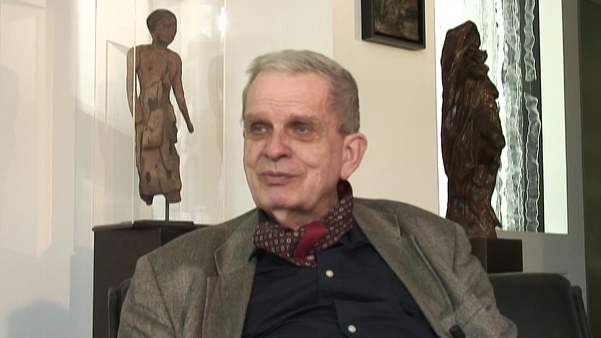NEXT STORY

My closest circle
RELATED STORIES

NEXT STORY

My closest circle
RELATED STORIES


|
Views | Duration | |
|---|---|---|---|
| 41. Jerzy Giedroyc | 47 | 00:49 | |
| 42. My translations | 45 | 03:58 | |
| 43. Natalya Gorbanevskaya | 46 | 01:34 | |
| 44. My closest circle | 39 | 01:10 | |
| 45. Feeling isolated from society | 42 | 01:45 | |
| 46. The decision to emigrate | 43 | 01:20 | |
| 47. My letter to the Central Committee of the Lithuanian Communist... | 70 | 03:23 | |
| 48. Recognition from the West | 35 | 01:31 | |
| 49. 'Stay in Lithuania' | 63 | 02:57 | |
| 50. Arthur Miller's defending letter | 85 | 00:45 |


Po to čia, kaip tik, palaikiau tuos disidentinius ryšius, vis daugiau mažiau su tais pačiais asmenimis. Su tuo pačiu Aleksandru Ginzburgu, kuris kadaise redagavo žurnalą "Sintaksė" arba "Sintaksis", ir paskui, kaip žinote, buvo kalėjime. Bet jis kartkartėmis buvo ir laisvėje ir tada su juo galima buvo pabendrauti. Taip pat su Natalija Gorbanevskaja. Neatsimenu ar aš jau ją minėjau, bet jinai rusų pradedanti poetė buvo tada, irgi Brodskio bičiulė, ir Brodskis ją aukštai vertino jos poeziją. Bet daugiausia buvo rezistentė, daugiausia, taip sakant, priešinosi valdžiai. Ir kada sovietinė kariuomenė įsiveržė į Čekoslovakiją, šeši asmenys surengė protesto demonstraciją prieš tai Raudonojoje aikštėje. Ta demonstracija truko tik... gal mažiau negu minutę, nes juos tuoj užpuolė saugumiečiai, areštavo. Gorbanevskaja toje demonstracijoje dalyvavo, labai išgarsėjo, paskui , po daugelio metų, gavo laisvos jau Čekijos garbės pilietybę, o paskui buvo kalinama, buvo laikoma psichiatrinėje ligoninėje, emigravo ir šiuo metu gyvena Paryžiuje.
After that, as it happens, I kept up my contacts with those dissidents, more or less with the same people. With Alexander Ginzburg, whom I’ve already mentioned and who had earlier edited the journal Syntax or Sitaksis and later, as you know, served a prison sentence. But he spent periods outside of prison and I was then able to spend time with him. And, with Natalya Gorbanevskaya. I don’t remember if I’ve already mentioned her but she was a young Russian poet then, also a friend of [Joseph] Brodsky, and Brodsky thought highly of her poetry. But mainly she was in the opposition, mainly, as it were, she was against the authorities. And when the Soviet army invaded Czechoslovakia, six people organised a protest against that invasion in Red Square. That demonstration took only… less than a minute because the state security forces attacked them, arrested them. Gorbanevskaya took part in that demonstration, she became very well known. Later, after many years, she became an honorary citizen of the Czech Republic, and after that she was imprisoned, kept in a psychiatric hospital, emigrated and now lives in Paris.
Born in 1937, Tomas Venclova is a Lithuanian scholar, poet, author and translator of literature. He was educated at Vilnius University and later at Tartu University. As an active participant in the dissident movement he was deprived of Soviet citizenship in 1977 and had to emigrate. Between 1977 and 1980 he lectured at University of California, Berkeley, where he became friends with the Polish poet Czesław Miłosz, who was a professor of Slavic Languages and Literature at the school, as well as the Russian poet Joseph Brodsky. He is currently a full professor at Yale University.
Title: Natalya Gorbanevskaya
Listeners: Andrzej Wolski
Film director and documentary maker, Andrzej Wolski has made around 40 films since 1982 for French television, the BBC, TVP and other TV networks. He specializes in portraits and in historical films. Films that he has directed or written the screenplay for include Kultura, which he co-directed with Agnieszka Holland, and KOR which presents the history of the Worker’s Defence Committee as told by its members. Andrzej Wolski has received many awards for his work, including the UNESCO Grand Prix at the Festival du Film d’Art.
Tags: Syntax, Czechoslovakia, Czech Republic, Alexander Ginzburg, Natalya Gorbanevskaya
Duration: 1 minute, 34 seconds
Date story recorded: May/June 2011
Date story went live: 20 March 2012